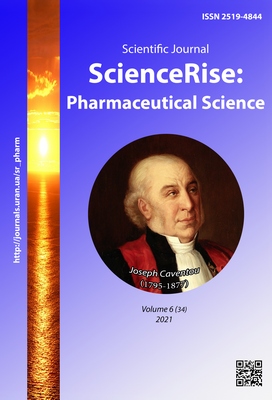Identification of benzydamine and its metabolit in the presence of certain anti-inflammatory non-steroidal drugs
DOI:
https://doi.org/10.15587/2519-4852.2021.249634Keywords:
benzydamine hydrochloride, screening, benzydamine N – oxide, thin layer chromatography, high-performance liquid chromatographyAbstract
The aim of the work. Currently, a large number of cases of non-medical use of benzydamine hydrochloride have been described. The identification of benzydamine and its metabolite, benzydamine N-oxide, in the presence of some non-steroidal anti-inflammatory drugs, has been insufficiently studied. Therefore, the development of a method for its identification in biological material is an urgent task.
Materials and methods. The subjects of the study were benzydamine hydrochloride and its metabolite, as well as some non-steroidal anti-inflammatory drugs, which are its analogues in terms of pharmacological action. The studies were carried out by methods of thin layer chromatography and high-performance liquid chromatography.
Results. At the first stage a screening method for benzydamine identification was studied using the extraction in acidic and basic conditions. It was shown that benzydamine can be isolated in both medias with subsequent development with a solution of iodoplatinate and Dragendorff's reagent according to Munier or with Mandelin reagent respectively. The mobile phase was selected and respective hRf for the target molecule were defined.
After a preliminary identification of benzydamine a reference method for the final confirmation of the drug that had led to poisoning was proposed. A robust, specific and accurate reversed phase HPLC method was chosen. It was shown that benzydamine exists in biological material mainly in a form of metabolite – benzydamine N-oxide. The selected method was able to separate and determine key analytes in biological samples after a preparative isolation by TLC method. The comparison with UV spectra of the reference standard of benzydamine hydrochloride was proposed to avoid false positive conclusion of drug identification.
Conclusions. Proposed methodology can be applied for routine identification of benzydamine poisoning in toxicological laboratories
References
- Gunaydin, C., Bilge, S. S. (2018). Effects of Nonsteroidal Anti-Inflammatory Drugs at the Molecular Level. The Eurasian Journal of Medicine, 50 (2), 116–121. doi: http://doi.org/10.5152/eurasianjmed.2018.0010
- Kuriyama, A., Aga, M., Maeda, H. (2018). Topical benzydamine hydrochloride for prevention of postoperative sore throat in adults undergoing tracheal intubation for elective surgery: a systematic review and meta-analysis. Anaesthesia, 73 (7), 889–900. doi: http://doi.org/10.1111/anae.14224
- Sein Anand, J., Lukasik-Glębocka, M., Paweł Korolkiewicz, R. (2007). Recreational abuse with benzydamine hydrochloride (tantum rosa). Clinical Toxicology, 45 (2), 198–199. doi: http://doi.org/10.1080/15563650600981210
- Reed, P. (2017). Sussex research reveals the addictive potential of a drug legally available in the UK and other countries. University of Sussex. Available at: https://www.sussex.ac.uk/broadcast/read/40139
- Opaleye, E. S., Noto, A. R., Sanchez, Z. van der M., Moura, Y. G. de, Galduróz, J. C. F., Carlini, E. A. (2009). Recreational use of benzydamine as a hallucinogen among street youth in Brazil. Revista Brasileira de Psiquiatria, 31 (3), 208–213. doi: http://doi.org/10.1590/s1516-44462009000300005
- Mota, D. M., Costa, A. A. da, Teixeira, C. dos S., Bastos, A. A., Dias, M. F. (2010). Use abusive of benzydamine in Brazil: an overview in pharmacovigilance. Ciência & Saúde Coletiva, 15 (3), 717–724. doi: http://doi.org/10.1590/s1413-81232010000300014
- Balaban, O. D., Atagun, M. I., Yilmaz, H., Yazar, M. S., Alpkan, L. R. (2013). Benzydamine Abuse as a Hallucinogen: A Case Report. Klinik Psikofarmakoloji Bülteni-Bulletin of Clinical Psychopharmacology, 23 (3), 276–279. doi: http://doi.org/10.5455/bcp.20111212083751
- Can, B., Oz, I., Ozer, H., Simsek, T. (2016). Hallucinations after Ingesting a High Dose of Benzydamine Hydrochloride. Clinical Psychopharmacology and Neuroscience, 14 (4), 407–408. doi: http://doi.org/10.9758/cpn.2016.14.4.407
- Acar, Y. A., Kalkan, M., Çetin, R., Çevik, E., Çınar, O. (2014). Acute Psychotic Symptoms due to Benzydamine Hydrochloride Abuse with Alcohol. Case Reports in Psychiatry, 2014, 1–2. doi: http://doi.org/10.1155/2014/290365
- Gürü, M., Şafak, Y., Cengiz, G. F., Kuru, E., Örsel, S. (2019). Chronic psychosis related to benzydamine hydrochloride abuse. Neurocase, 25 (3-4), 156–158. doi: http://doi.org/10.1080/13554794.2019.1617318
- Schifano, F., Corazza, O., Marchi, A., Melchiorre, G. D., Sferrazza, E., Enea, A. et. al. (2013). Analysis of online reports on the potential misuse of benzidamine. Rivista di Psichiatria, 48 (3), 182–186. doi: http://doi.org/10.1708/1292.14286
- Robinson, N. A., Scully, C. (2016). Oral health: Mouthwash abuse. British Dental Journal, 221 (6), 280–280. doi: http://doi.org/10.1038/sj.bdj.2016.663
- Chiappini, S., Guirguis, A., Corkery, J. M., Schifano, F. (2020). Misuse of prescription and over-the-counter drugs to obtain illicit highs: how pharmacists can prevent abuse. Pharmaceutical Journal. doi: http://doi.org/10.1211/pj.2020.20208538
- Pubchem. Benzydamine (Compound). Available at: https://pubchem.ncbi.nlm.nih.gov/compound/12555#section=Information-Sources
- Naser, I. (2006). Izuchenie khromatograficheskogo povedeniia valproevoi kisloty v smesi s drugimi veschestvami kislogo kharaktera. Teorіia ta praktika sudovoi ekspertizi і krimіnalіstiki, 6, 302–305.
- Nasser, I. (2008). Rozrobka metodiv analitychnoyi diahnostyky otruyen valproyevoyu kyslotoyu. Kyiv, 163.
- Catanese, B., Lagana, A., Marino, A., Picollo, R., Rotatori, M. (1986). HPLC determination of benzydamine and its metabolite N-oxide in plasma following oral administration or topical application in man, using fluorimetric detection. Pharmacological Research Communications, 18 (4), 385–403. doi: http://doi.org/10.1016/0031-6989(86)90091-3
- Cherniy, V. A., Gureeva, S. N., Georgiyants, V. A. (2016). Development and Validation of Alternative Analytical Method for Determination of Related Substances of Benzydamine Hydrochloride in Oral Spray by HPLC. Journal of Drug Design and Medicinal Chemistry, 2 (6), 65–73.
- Chornyi, V., Chorna, O., Georgiyants, V. (2020). Development and validation of the method for simultaneous determination of Benzydamine hydrochloride and methylparaben in dosage form by HPLC. ScienceRise: Pharmaceutical Science, 3 (25), 12–19. doi: http://doi.org/10.15587/2519-4852.2020.206579
- Moffat, A. C., Osselton, M. D., Widdop, B. (2011). Clarke’s Analysis of Drugs and Poisons. Pharmaceutical Press, 2736.
Downloads
Published
How to Cite
Issue
Section
License
Copyright (c) 2021 Olga Chorna, Vasyl Chornyi, Oleksandr Сhubenko, Ihor Hrubnyk, Volodymyr Mishchenko

This work is licensed under a Creative Commons Attribution 4.0 International License.
Our journal abides by the Creative Commons CC BY copyright rights and permissions for open access journals.








